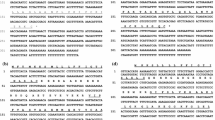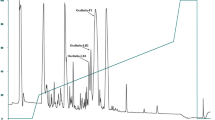Abstract
Amphibian skin secretions contain a broad spectrum of biologically active compounds, particularly antimicrobial peptides, which are considered to constitute a first line of defence against bacterial infection. Here we describe the identification of two prototype peptides representing a novel structural class of antimicrobial peptide from the skin secretion of the oriental broad-folded frog, Hylarana latouchii. Named hylaranin-L1 (GVLSAFKNALPGIMKIIVamide) and hylaranin-L2 (GVLSVIKNALPGIMRFIAamide), both peptides consist of 18 amino acid residues, are C-terminally amidated and are of unique primary structures. Their primary structures were initially deduced by MS/MS fragmentation sequencing from reverse-phase HPLC fractions of skin secretion that demonstrated antimicrobial activity. Subsequently, their precursor-encoding cDNAs were cloned from a skin secretion-derived cDNA library and their primary structures were confirmed unequivocally. Synthetic replicates of both peptides exhibited broad-spectrum antimicrobial activity with mean inhibitory concentrations (MICs) of 34 μM against Gram-negative Escherichia coli, 4.3 μM against Gram-positive Staphylococcus aureus and 4–9 μM against the yeast, Candida albicans. Both peptides exhibited little haemolytic activity (<6 %) at the MICs for S. aureus and C. albicans. Amphibian skin secretions thus continue to provide novel antimicrobial peptide structures that may prove to be lead compounds in the design of new classes of anti-infection therapeutics.







Similar content being viewed by others
References
Arnold K, Bordoli L, Kopp J, Schwede T (2006) The SWISS-MODEL workspace: a web-based environment for protein structure homology modelling. Bioinformatics 22:195–201
Bevins CL, Zasloff M (1990) Peptides from frog skin. Annu Rev Biochem 59:395–414
Bowie JH, Separovic F, Tyler MJ (2012) Host-defense peptides of Australian anurans. Part 2. Structure, activity, mechanism of action, and evolutionary significance. Peptides 37:174–188
Conlon JM (2011) Structural diversity and species distribution of host-defense peptides in frog skin secretions. Cell Mol Life Sci 68:2303–2315
Conlon JM, Kolodziejek J, Nowotny N (2004) Antimicrobial peptides from ranid frogs: taxonomic and phylogenetic markers and a potential source of new therapeutic agents. Biochim Biophys Acta 1696:1–14
Davies J, Davies D (2010) Origins and evolution of antibiotic resistance. Microbiol Mol Biol Rev 74:417–433
Erspamer V (1994) Bioactive secretions of the integument, amphibian biology. In: Heatwole H, Barthalmus T (eds) The integument, vol 1. Surrey Beatty and Sons, Chipping Norton, pp 178–350
Hancock REW (2000) Cationic antimicrobial peptides, towards clinical applications. Expert Opin Investig Drugs 9:1723–1729
Haney EF, Hunter HN, Matsuzaki K, Vogel HJ (2009) Solution NMR studies of amphibian antimicrobial peptides: linking structure to function? Biochim Biophys Acta 1788:1639–1655
Matsuzaki K (1999) Why and how are peptide–lipid interactions utilized for self-defense? Magainins and tachyplesins as archetypes. Biochim Biophys Acta 1462:1–10
Park Y, Hahm KS (2005) Antimicrobial peptides (AMPs): peptide structure and mode of action. J Biochem Mol Biol 38:507–516
Rinaldi AC (2002) Antimicrobial peptides from amphibian skin: an expanding scenario. Curr Opin Chem Biol 6:799–804
Saleem M, Nazir M, Ali MS, Hussain H, Lee YS, Riaz N, Jabbar A (2010) Antimicrobial natural products: an update on future antibiotic drug candidates. Nat Prod Rep 27:238–254
Simmaco M, Mignogna G, Barra D (1998) Antimicrobial peptides from amphibian skin: what do they tell us? Biopolymers 47:435–450
Teixeira V, Feio MJ, Bastos M (2012) Role of lipids in the interaction of antimicrobial peptides with membranes. Prog Lipid Res 51:149–177
Thomas P, Kumar TV, Reshmy V, Kumar KS, George S (2012) A mini review on the antimicrobial peptides isolated from the genus Hylarana (Amphibia: Anura) with a proposed nomenclature for amphibian skin peptides. Mol Biol Rep 39:6943–6947
Tyler MJ, Stone DJM, Bowie JH (1992) A novel method for the release and collection of dermal, glandular secretions from the skin of frogs. J Pharmacol Toxicol Methods 28:199–200
Wang H, Li R, Xi X, Meng T, Zhou M, Wang L, Zhang Y, Chen T, Shaw C (2013) Senegalin: a novel antimicrobial/myotropic hexadecapeptide from the skin secretion of the African running frog, Kassina senegalensis. Amino Acids 44:1347–1355
Yeaman MR, Yount NY (2003) Mechanisms of antimicrobial peptide action and resistance. Pharmacol Rev 55:27–55
Yount NY, Bayer AS, Xiong YQ, Yeaman MR (2006) Advances in antimicrobial peptide immunobiology. Biopolymers 84:435–458
Zasloff M (1987) Magainins, a class of antimicrobial peptides from Xenopus skin: isolation, characterization of two active forms, and partial cDNA sequence of a precursor. Proc Natl Acad Sci USA 84:5449–5453
Conflict of interest
The authors declare that they have no conflict of interests.
Author information
Authors and Affiliations
Corresponding authors
Additional information
Y. Lin and N. Hu contributed equally to this work.
Rights and permissions
About this article
Cite this article
Lin, Y., Hu, N., Lyu, P. et al. Hylaranins: prototypes of a new class of amphibian antimicrobial peptide from the skin secretion of the oriental broad-folded frog, Hylarana latouchii . Amino Acids 46, 901–909 (2014). https://doi.org/10.1007/s00726-013-1655-1
Received:
Accepted:
Published:
Issue Date:
DOI: https://doi.org/10.1007/s00726-013-1655-1




